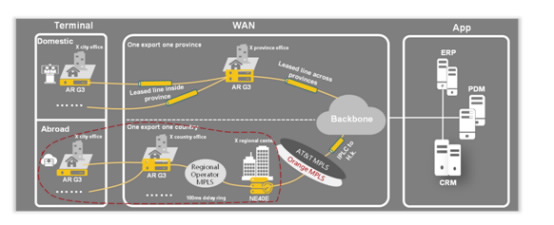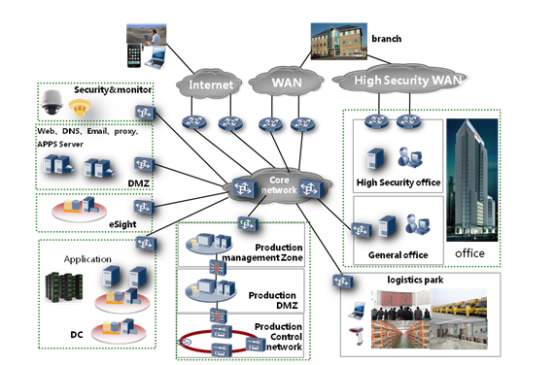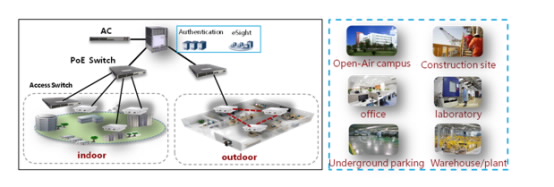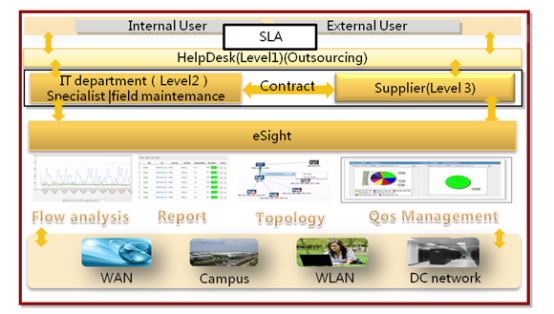The enterprise network is the basis of IT construction and the bearing platform. The network bears enterprise ERP, Supply Chain Management (SCM), email, voice, video, and other services. Traditional network construction puts more emphasis on current business; however, with rapid global expansion and a constant stream of new online businesses, traditional network construction has gradually become a major bottleneck, presenting the following snags:
- Lagging business development
- Poor availability
- Longer business delaysJittery video images
- Frequent network faults
- Poor user experience
It is often difficult to send onsite data back to the database at headquarters. This bottleneck jeopardizes data synchronization between branches and headquarters, causing disarray in branch device management, expensive line leases, slow business deployments, and high costs.
Based on the principle of iniquitousness, high availability, and security, Huawei has developed the Large Enterprise Infrastructure Network Solution to help large enterprise build an infrastructure network. Huawei hopes to share its own practical global network experience to enterprise customers.
Large Enterprise WAN Solution
This solution is suitable for Group Enterprise Wide Area Network (WAN) construction.
The hierarchical network structure stabilizes and strengthens the network. In China, the WAN backbone layer is built through the multi-core node. Abroad, Huawei adopts international operators’ bicyclo-MPLS (such as AT&T and Orange) to build the backbone layer. Other regional data centers connect to the two supplier MPLS networks. Through regional operators, each national representative office connects to the enterprise network to enable regional convergence.
At the access layer, for unified regional export, one export one country (province) greatly simplifies the network topology and reduces bandwidth rent cost by making full use of local lines.
Multi-level reliability management based on the Service Level Agreement (SLA) ensures of reliability, load balancing, and cost savings.
The regional 100 ms delay ring makes the supply chain, financial, research and development systems fall to the ground globally, guaranteeing a unified regional business experience.

Figure: Large Enterprise WAN Solution
Large Enterprise Scenario-based Campus Network Solution
This solution satisfies different campus network needs of various sizes and application scenarios, including all types of campus networks, such as headquarters, regional centers, branches, general offices, high-security offices, visitor areas, meeting rooms, laboratories, factories, warehouses, and logistics parks. Office network flexibility and production and research security are all considered.
Adopting the MPLS strategy, Huawei divides development into research, non-research, and general network areas to realize safety isolation and access control of different businesses and to guarantee research information security.

Figure : Large Enterprise Scenario-based Campus Network Solution
Large Enterprise WLAN Solution
This solution is suitable for enterprise network transformation to increase WLAN coverage and for new enterprise networks considering wired and wireless integrated network access.
The solution provides wireless office, wireless conferencing and training, wireless laboratory environment, open-air campus, construction sites, underground parking, plants, warehouses, and visitor area networks.
This solution proposes an all-IP, wired, and wireless integrated access network. Integrated network operation and maintenance and unified identity ensure flexibility and security. One-stop configuration can lower workloads by 80 percent.
In addition, Huawei’s new-generation, high performance, high capacity Access Point (AP) offers the following features:
- Theoretical bit rate of greater than Gbit
- Meets protection level for IP66 of -40 ~ 60℃.
- Increases outdoor coverage by 30 percent.
- Reduces equipment investment by 20 percent.

Figure : Large Enterprise WLAN Solution
Data Center Cloud Network Solution
This solution is suitable for large enterprise data center network construction.
According to the enterprise scale and business requirements, this solution can help customers establish the most suitable data center network for their needs. The solution provides multi-level network products for internal interconnection, cross-data center interconnection, disaster recovery, security, and data center management. The Huawei solution offers the following advantages:
- Flexible and extensible: Two-dimensional virtualization and the no-block exchange 360 T network meet multi-generational server access, lowering Total Cost of Operation (TCO).
- High reliability: VS + CSS + Trunking reduce business loss and maintenance costs.
- High Security:A variety of protection strategies ensure secure server access.
- Cloud Evolution Support: Supports 512-node TRILL standard, big layer 2 networks, enabling large transverse flow and virtual calculation.
Identity Authentication and Authorization Solution
This solution is suitable for identity authentication and authorization for multi-user, multi-area, multi-way, and multi-terminal access networks.
Solution enables multi-account user management, including local accounts, AD domain accounts, third-party LDAP accounts, CA/PKI, MAC, etc. It can also manage users, visitors, general employees, core employees, and key employee’s to allow secure access of the network via fixed terminals, mobile devices, and exceptional devices. Through grade authorization, the solution can enable comprehensive user management. Authorized users can access inner enterprise resources and the Internet, and access methods, contexts, and applications are tightly restricted and monitored.
Business Bearing Network Solution
This solution is suitable for high-quality key enterprise business experience, including Office Automation (OA), VoIP, email, e-flow, Product Data Management (PDM), APS, Enterprise Resource Planning (ERP), Manufacturing Execution Systems (MES), and others.
According to unique business characteristics, Huawei provides targeted solutions for building high quality business experience assurance systems through agile deployments of key business, 100 ms delay ring, WAN acceleration, and diff-Qos. As required, Huawei can agilely configure and adjust bandwidth and routinely review and analyze network flow to guarantee high business performance.
Efficient Network Management Platform
This solution is ideal for enterprise network operation and maintenance management.
Based on extensive experience in enterprise network management efficiency, Huawei adopted eSight, an ITIL-based advanced network management system. Through eSight, Huawei has built multi-level operation and support systems, including many end-to-end solutions such as business Service Level Agreement (SLA) monitoring, business performance management, visualized management, etc. Statistics show that 85 percent of network faults can be solved via a remote network management system, 10 percent can be solved by exchanging devices, and only 5 percent must be resolved in the field. As a result, integrated and remote operation and maintenance can save up to 39 percent of costs.

Figure : Efficient Network Management Platform




